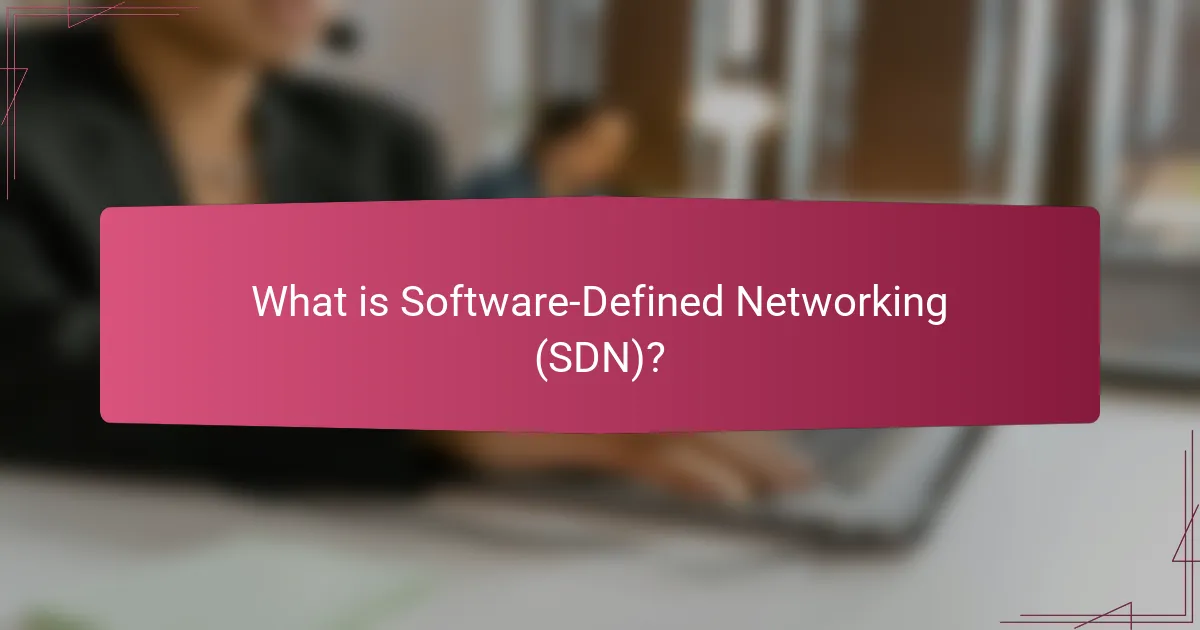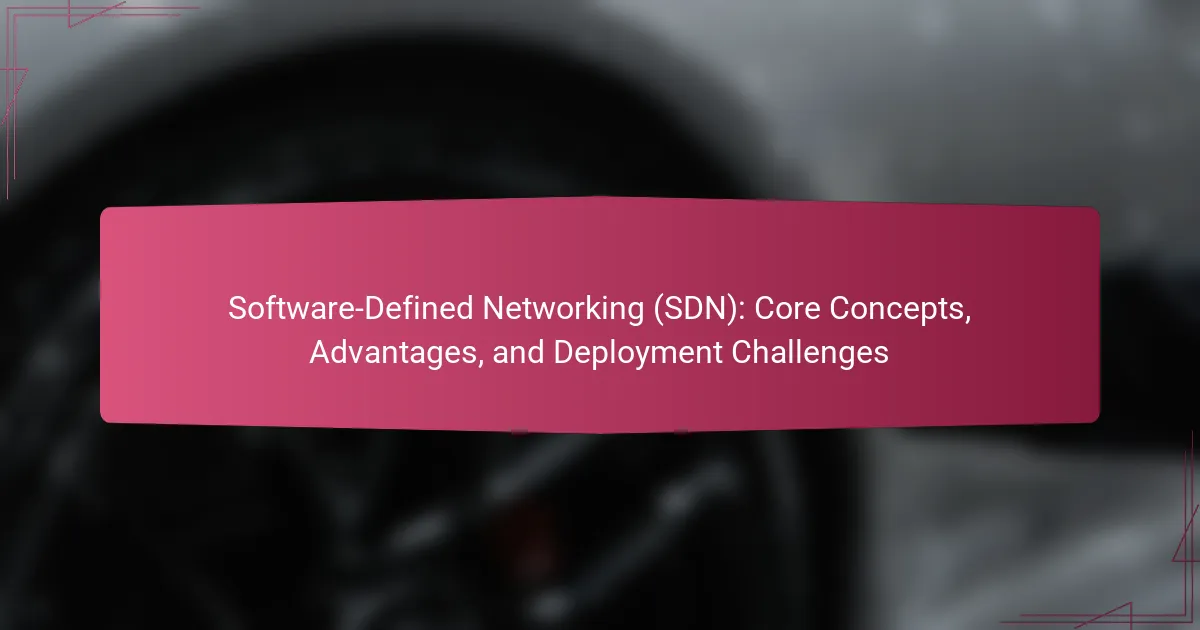
What is Software-Defined Networking (SDN)?
Software-Defined Networking (SDN) is an approach to networking that decouples the control plane from the data plane. This allows for centralized control of the network through software applications. SDN enables network administrators to manage network services through abstraction of lower-level functionality. The architecture promotes greater flexibility and efficiency in network management. It allows for dynamic adjustment of network resources based on real-time needs. SDN has been widely adopted in data centers and enterprise networks. According to a 2020 report by MarketsandMarkets, the SDN market is projected to grow from $8.5 billion in 2020 to $30.7 billion by 2025.
How does Software-Defined Networking (SDN) function?
Software-Defined Networking (SDN) functions by separating the control plane from the data plane in networking devices. This separation allows centralized control of network traffic through software applications. The SDN controller communicates with network devices using standardized protocols, such as OpenFlow. This enables dynamic management of network resources based on real-time needs. SDN enhances network flexibility and scalability. It allows for automated provisioning and configuration of network services. Additionally, SDN supports programmability, enabling developers to create custom applications for network management. This architecture optimizes resource utilization and improves overall network performance.
What are the key components of Software-Defined Networking (SDN)?
The key components of Software-Defined Networking (SDN) include the control layer, data plane, and application layer. The control layer consists of the SDN controller, which manages the network and provides a centralized view. The data plane refers to the physical network devices that forward traffic based on the controller’s instructions. The application layer includes network applications that utilize the SDN controller’s APIs to implement policies and manage resources. These components work together to enable programmable network management and dynamic resource allocation. This structure allows for increased flexibility and efficiency in network operations.
How do these components interact within Software-Defined Networking (SDN)?
In Software-Defined Networking (SDN), components interact through a centralized control plane and distributed data plane. The control plane, managed by the SDN controller, makes decisions about network traffic flow. It communicates with network devices via protocols like OpenFlow. The data plane consists of network devices that forward traffic based on rules provided by the control plane. This separation allows for dynamic network management and optimization. SDN enables programmability, allowing applications to request network resources in real-time. This interaction enhances network agility and efficiency. The architecture improves scalability and reduces operational costs by centralizing control.
What are the core principles of Software-Defined Networking (SDN)?
The core principles of Software-Defined Networking (SDN) are separation of control and data planes, centralized control, programmability, and automation. Separation of control and data planes allows for network management and traffic forwarding to occur independently. This enhances flexibility and enables more efficient resource allocation. Centralized control provides a single point of management, simplifying network configuration and monitoring. Programmability allows network administrators to customize network behavior through software applications. Automation facilitates dynamic network adjustments based on real-time conditions, improving responsiveness. These principles collectively enhance network agility, scalability, and operational efficiency.
Why is separation of control and data planes important in Software-Defined Networking (SDN)?
Separation of control and data planes is crucial in Software-Defined Networking (SDN) because it enhances network management and flexibility. This separation allows the control plane to manage network policies independently from the data plane, which handles the actual data traffic. By decoupling these functions, SDN enables centralized control, making it easier to implement changes across the network. It also facilitates dynamic resource allocation and improved network efficiency. Research shows that this architecture allows for faster innovation and adaptation to changing network demands, as evidenced by the increased deployment of SDN solutions in modern data centers.
How does programmability impact Software-Defined Networking (SDN)?
Programmability enhances Software-Defined Networking (SDN) by allowing dynamic network management and automation. It enables network administrators to customize and optimize network behavior through software applications. This flexibility leads to improved resource allocation and faster response to network changes. Programmability supports the development of network functions as applications, promoting innovation. It also facilitates integration with cloud services and third-party applications. Evidence of its impact includes the adoption of OpenFlow, which allows for programmable flow control in SDN environments. According to a 2021 study by the International Journal of Network Management, SDN with programmability showed a 30% increase in efficiency in data traffic management.
What are the main use cases of Software-Defined Networking (SDN)?
The main use cases of Software-Defined Networking (SDN) include network virtualization, dynamic traffic management, and enhanced security. Network virtualization allows multiple virtual networks to operate on a single physical infrastructure. This improves resource utilization and simplifies network management. Dynamic traffic management optimizes data flow in real-time. It enables efficient bandwidth allocation based on current network conditions. Enhanced security involves centralized control for better monitoring and response to threats. SDN architecture facilitates rapid deployment of security policies across the network. These use cases demonstrate SDN’s ability to improve network flexibility and operational efficiency.
Which industries are adopting Software-Defined Networking (SDN)?
The industries adopting Software-Defined Networking (SDN) include telecommunications, data centers, cloud computing, and enterprise networking. Telecommunications companies utilize SDN to enhance network management and flexibility. Data centers implement SDN for improved resource allocation and scalability. Cloud computing providers leverage SDN to optimize service delivery and customer experience. Enterprise networking adopts SDN to streamline operations and reduce costs. According to a report by MarketsandMarkets, the global SDN market is expected to grow significantly, indicating widespread industry adoption.
How is Software-Defined Networking (SDN) applied in data centers?
Software-Defined Networking (SDN) is applied in data centers by centralizing network control and management. This approach allows for dynamic network configuration and resource allocation. SDN decouples the control plane from the data plane. This separation enables more efficient traffic management and policy enforcement. Data center operators can automate network provisioning and scaling. SDN enhances network visibility and monitoring capabilities. It also supports multi-tenancy and network segmentation for security. Research from the IEEE indicates that SDN improves data center efficiency by up to 30%.

What are the advantages of Software-Defined Networking (SDN)?
Software-Defined Networking (SDN) offers several advantages. It enables centralized control of the network, simplifying management. This centralization allows for rapid configuration changes and scalability. SDN improves network agility, enabling quick adaptation to changing demands. It also enhances automation, reducing manual intervention and the potential for human error. Additionally, SDN supports network programmability, allowing developers to create custom applications. Security is improved through better visibility and control of traffic flows. According to a report by Gartner, SDN can reduce operational costs by up to 30%. These benefits collectively contribute to more efficient and flexible network management.
How does Software-Defined Networking (SDN) improve network management?
Software-Defined Networking (SDN) improves network management by centralizing control and enabling programmability. This architecture separates the control plane from the data plane. Network administrators gain a global view of the network through a centralized controller. This allows for real-time monitoring and management of network resources. SDN facilitates automated provisioning of network devices. It also simplifies configuration changes across multiple devices simultaneously. According to research from the Open Networking Foundation, SDN reduces operational costs by up to 30%. Additionally, SDN enhances network flexibility and agility, allowing for quick adaptation to changing business needs.
What efficiencies does Software-Defined Networking (SDN) provide?
Software-Defined Networking (SDN) provides enhanced network management efficiencies. It allows centralized control of network resources. This centralization simplifies configuration and monitoring tasks. SDN automates network provisioning, reducing manual intervention. It enables dynamic resource allocation based on real-time demands. SDN also enhances network scalability, allowing quick adjustments to traffic loads. Furthermore, it improves network visibility, facilitating better performance analytics. These efficiencies lead to reduced operational costs and improved service delivery.
How does Software-Defined Networking (SDN) enhance scalability?
Software-Defined Networking (SDN) enhances scalability by centralizing network control and enabling dynamic resource allocation. This architecture allows for the rapid provisioning of network resources as demand grows. SDN separates the control plane from the data plane, facilitating easier management of network resources. This separation enables network administrators to adjust bandwidth and configurations without physical hardware changes. Additionally, SDN supports automation through programmable interfaces, which further streamlines the scaling process. According to a study by Cisco, SDN can reduce operational costs by up to 30% while improving network performance. These features collectively contribute to a more scalable network infrastructure.
What cost benefits does Software-Defined Networking (SDN) offer?
Software-Defined Networking (SDN) offers significant cost benefits by reducing hardware expenses and operational costs. It allows for centralized management, which simplifies network configuration and reduces the need for specialized personnel. SDN enables the use of commodity hardware, lowering capital expenditure compared to traditional networking solutions. According to a study by the Open Networking Foundation, organizations can save up to 30% on operational costs through automation and streamlined processes. Additionally, SDN’s flexibility allows for quicker deployment of services, minimizing downtime and associated costs. Overall, these factors contribute to a more cost-effective networking solution.
How does Software-Defined Networking (SDN) reduce operational costs?
Software-Defined Networking (SDN) reduces operational costs by centralizing network management and automating configuration tasks. This centralization allows for more efficient resource allocation. It eliminates the need for extensive hardware investments by enabling the use of commodity hardware. Automation reduces the time and labor required for network management tasks. Studies show that organizations adopting SDN have reported up to a 30% reduction in operational costs. Additionally, SDN supports dynamic scaling, allowing companies to adjust resources based on demand, further optimizing expenses.
What is the impact of Software-Defined Networking (SDN) on capital expenditures?
Software-Defined Networking (SDN) significantly reduces capital expenditures. SDN achieves this by centralizing network management and automating configuration processes. This reduces the need for expensive hardware investments. Traditional networking often requires multiple physical devices. In contrast, SDN allows for the use of software-based solutions. According to a study by Gartner, organizations can save up to 30% on networking costs with SDN. The flexibility of SDN also enables more efficient resource allocation. Overall, SDN streamlines operations and lowers overall infrastructure costs.
How does Software-Defined Networking (SDN) improve security?
Software-Defined Networking (SDN) improves security by centralizing control of the network. This centralization allows for real-time monitoring and management of network traffic. SDN enables dynamic security policies that can adapt to emerging threats. It facilitates automated responses to suspicious activities. SDN architecture isolates applications from the underlying hardware, reducing vulnerabilities. Furthermore, it allows for the segmentation of networks, limiting the spread of potential attacks. A study by the International Journal of Computer Applications highlights that SDN can reduce security incidents by enhancing visibility and control. This proactive approach to security makes networks more resilient against cyber threats.
What security features are inherent in Software-Defined Networking (SDN)?
Software-Defined Networking (SDN) incorporates several inherent security features. These features include centralized control, which allows for better visibility and monitoring of network traffic. SDN enables dynamic policy enforcement, allowing administrators to quickly adapt security measures in response to threats.
Isolation of control and data planes enhances security by reducing the attack surface. SDN also supports automated threat detection through real-time analytics, improving response times to potential security incidents. Furthermore, programmable network configurations allow for rapid updates to security protocols.
Research indicates that SDN can significantly improve network resilience against attacks by enabling proactive security measures (source: “A Survey on Security in Software-Defined Networking,” authors: A. K. Sharma, R. P. Singh, 2021).
How can Software-Defined Networking (SDN) mitigate risks?
Software-Defined Networking (SDN) mitigates risks by enhancing network visibility and control. SDN centralizes network management, allowing for real-time monitoring of traffic and potential threats. This centralized control helps in quickly identifying anomalies that may indicate security breaches. Additionally, SDN enables automated responses to security incidents, reducing the response time significantly. By implementing policies and security measures programmatically, organizations can adapt to emerging threats more effectively. Research shows that SDN can improve network security posture by 30% due to its agile nature in addressing vulnerabilities. This adaptability is crucial in dynamic environments where traditional security measures may fall short.

What are the deployment challenges of Software-Defined Networking (SDN)?
Deployment challenges of Software-Defined Networking (SDN) include integration with legacy systems, security concerns, and complexity in management. Integrating SDN with existing network infrastructure can be difficult. Legacy systems may not support SDN protocols, leading to compatibility issues. Security is a significant concern, as centralized control can create vulnerabilities. Managing SDN environments adds complexity due to the need for specialized skills. Additionally, network performance can be affected during the transition to SDN. These challenges can hinder the adoption of SDN in organizations.
What technical challenges are associated with Software-Defined Networking (SDN) implementation?
Software-Defined Networking (SDN) implementation faces several technical challenges. One major challenge is interoperability with existing network infrastructure. Many legacy systems may not support SDN protocols or architectures. This can lead to integration issues and increased costs. Another challenge is the complexity of network management. SDN centralizes control, which can create a single point of failure if not managed properly. Security concerns also arise, as centralized control can be more vulnerable to attacks. Additionally, there is a steep learning curve for IT staff. They need to acquire new skills to manage SDN environments effectively. Performance issues may occur due to added latency from the control layer. Finally, compliance with regulatory standards can complicate SDN deployment. These challenges require careful planning and resource allocation to address effectively.
How does legacy infrastructure impact Software-Defined Networking (SDN) deployment?
Legacy infrastructure can significantly hinder Software-Defined Networking (SDN) deployment. It often lacks the flexibility and scalability required for SDN. Traditional hardware may not support the necessary virtualization technologies. This limitation can lead to increased costs and longer deployment times. Additionally, legacy systems may create compatibility issues with modern SDN solutions. These challenges can result in suboptimal network performance. A study by Gartner indicates that 70% of organizations face difficulties integrating SDN with existing legacy systems. Therefore, addressing these legacy constraints is crucial for successful SDN implementation.
What interoperability issues may arise with Software-Defined Networking (SDN)?
Interoperability issues in Software-Defined Networking (SDN) may arise due to differing vendor implementations. Various manufacturers may use proprietary protocols that hinder seamless integration. This can lead to challenges in managing diverse hardware and software components effectively. Additionally, SDN relies heavily on APIs for communication. Inconsistent API standards can create barriers between systems. Legacy systems may also struggle to interact with newer SDN architectures. This can result in increased complexity during network management. Furthermore, lack of uniformity in network policies can complicate policy enforcement across different devices. Overall, these interoperability challenges can impede the full potential of SDN deployments.
What are the organizational challenges when adopting Software-Defined Networking (SDN)?
Organizational challenges when adopting Software-Defined Networking (SDN) include skills gaps, integration issues, and resistance to change. Many IT teams lack the necessary expertise in SDN technologies. This knowledge gap can hinder effective implementation and management. Additionally, integrating SDN with existing legacy systems poses significant technical challenges. Organizations often face difficulties in ensuring compatibility and seamless operation. Resistance to change from staff can also impede adoption. Employees may be reluctant to shift from traditional networking practices to SDN. These challenges can delay deployment and impact the overall effectiveness of SDN initiatives.
How does staff training affect Software-Defined Networking (SDN) deployment?
Staff training significantly impacts Software-Defined Networking (SDN) deployment by enhancing the team’s technical skills and knowledge. Trained staff are better equipped to manage SDN architectures effectively. This expertise leads to quicker problem resolution and optimized network performance. According to a study by the International Journal of Network Management, organizations with well-trained staff experience 30% faster deployment times. Additionally, training reduces the risk of errors during implementation, which can lead to costly downtime. Overall, effective staff training is crucial for successful SDN deployment and operational efficiency.
What cultural shifts are necessary for successful Software-Defined Networking (SDN) adoption?
Successful Software-Defined Networking (SDN) adoption requires a shift towards collaboration and openness within organizations. Traditional silos in IT departments must be dismantled. This fosters better communication between networking, development, and operations teams. Embracing a DevOps culture is essential for integrating software development and IT operations. Organizations must prioritize continuous learning and adaptation to keep pace with technology changes. Leadership must support these cultural shifts through training and resource allocation. Research shows that companies with a collaborative culture see 30% higher performance in technology adoption. This evidence underscores the importance of cultural transformation in SDN implementation.
What best practices should be considered for successful Software-Defined Networking (SDN) implementation?
Successful Software-Defined Networking (SDN) implementation requires several best practices. First, organizations should define clear objectives for SDN deployment. This ensures that all stakeholders understand the goals. Second, a thorough assessment of existing infrastructure is essential. This helps identify compatibility issues and necessary upgrades. Third, selecting the right SDN architecture is crucial. Different architectures suit various organizational needs and scalability requirements. Fourth, ensuring robust security measures is vital. SDN environments can be vulnerable to new threats. Fifth, comprehensive training for IT staff is necessary. Skilled personnel can effectively manage and troubleshoot SDN systems. Finally, continuous monitoring and optimization should be implemented. This ensures that the SDN environment remains efficient and aligned with business goals.
How can organizations effectively plan for Software-Defined Networking (SDN) transitions?
Organizations can effectively plan for Software-Defined Networking (SDN) transitions by conducting a thorough assessment of their current network infrastructure. This involves identifying existing bottlenecks and understanding traffic patterns. Next, organizations should establish clear objectives for the SDN implementation. These objectives must align with overall business goals and include performance metrics.
Training staff on SDN technologies is crucial. This ensures that teams are equipped to manage the new architecture. Organizations should also develop a phased migration plan. This plan allows for gradual implementation, minimizing disruptions.
Regularly testing the new SDN environment is essential. It helps identify potential issues before full deployment. Engaging with experienced vendors can provide valuable insights and support. Research indicates that organizations that follow structured planning see improved network performance and reduced operational costs.
What strategies help mitigate risks during Software-Defined Networking (SDN) deployment?
Implementing a phased deployment strategy helps mitigate risks during Software-Defined Networking (SDN) deployment. This approach allows for gradual integration of SDN components. Testing in smaller environments minimizes the impact of potential failures. Establishing clear rollback procedures ensures quick recovery from issues. Regular training for IT staff enhances their readiness for new technologies. Comprehensive documentation supports troubleshooting and maintenance. Utilizing robust security protocols protects against vulnerabilities in the SDN architecture. Continuous monitoring of network performance identifies issues early, facilitating prompt resolution. These strategies collectively reduce the likelihood of significant disruptions during deployment.
Software-Defined Networking (SDN) is a networking approach that separates the control plane from the data plane, enabling centralized management through software applications. This architecture enhances flexibility, efficiency, and scalability in network operations, making it increasingly popular in data centers and enterprises. The article explores the core concepts of SDN, including its key components, principles, advantages, and use cases, while also addressing deployment challenges such as integration with legacy systems and the need for skilled personnel. Additionally, it highlights the significant cost benefits and security improvements that SDN can offer organizations.




